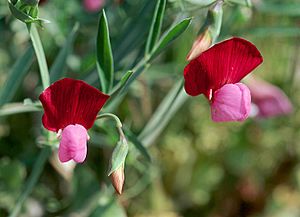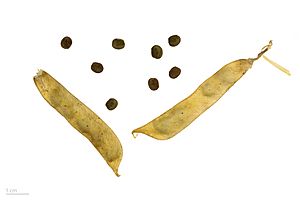Spanish vetchling facts for kids
Quick facts for kids Spanish vetchling |
|
|---|---|
 |
|
| Scientific classification | |
| Genus: |
Lathyrus
|
| Species: |
clymenum
|
| Synonyms | |
|
|
Lathyrus clymenum, also known as Spanish vetchling, is a beautiful flowering plant. It belongs to the Fabaceae family, which is also called the pea or bean family. This plant grows naturally around the Mediterranean Sea.
The seeds of the Spanish vetchling are used to make a special Greek dish. It is called fava santorinis. This plant is mostly grown on the island of Santorini in Greece. The European Union has given it a special status called Protected Designation of Origin. This means it is a unique product from that specific place.
Contents
What Makes Spanish Vetchling Special?
People on Santorini and nearby islands have grown Lathyrus clymenum for about 3,500 years. In most other places, this plant only grows wild.
Santorini's Unique Environment
Santorini island has a very special environment. This is because of ancient volcanic eruptions. The volcanic ash and unique soil help the plant grow. Also, the mix of sea air and dry weather makes the beans very special.
Farmers on the island can harvest a good amount of beans when the weather is right. They can get about 800 kilograms of beans from one hectare of land.
A Delicate Crop
Spanish vetchling is a delicate plant. Strong winds can blow away its flowers before they can make peas. It can also be harmed by dry weather or sudden heat waves. Because of these challenges, not much of this crop can be grown. This makes it an expensive plant to farm and buy.
Fava Santorinis Dish
Fava santorinis is a popular dish made from the cooked seeds of Lathyrus clymenum. The cooked fava beans are mashed into a smooth purée. People often serve it with chopped onion, olive oil, and lemon juice. It is a tasty and healthy part of Greek cuisine.
Nutritional Benefits
The plant Lathyrus clymenum, which makes 'Fava Santorinis', is very healthy. It has a lot of protein, about 25%. It is also an excellent source of dietary fibre, with about 26%. This plant is very low in fat. Most of its energy comes from complex carbohydrates and protein.
Even though it might look like some Indian lentil dishes, it is a different plant. It has a much higher nutritional value.
History of Legumes in Greece
People in Greece started growing pulses, like lentils, around 6,000 BC. For example, Lathyrus clymenum was found in jars in the ancient city of Akrotiri on Santorini. These jars date back to about 1600 BC.
Greece's climate has been perfect for these types of crops to grow over time. Greeks have learned how to cook them well. They have used their high nutritional value throughout history.
See also
 In Spanish: Lathyrus clymenum para niños
In Spanish: Lathyrus clymenum para niños


